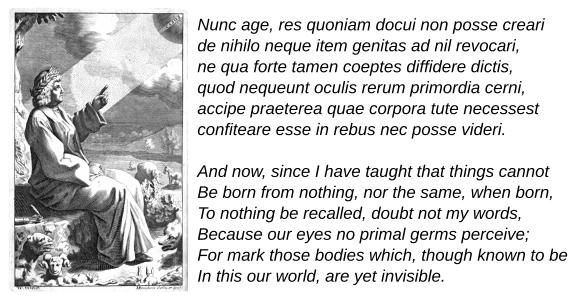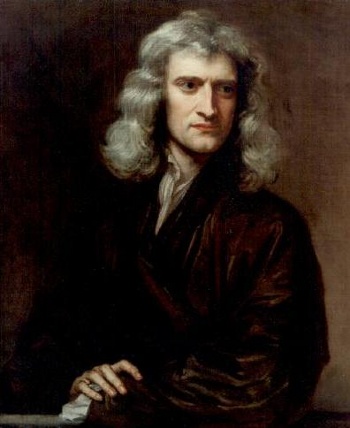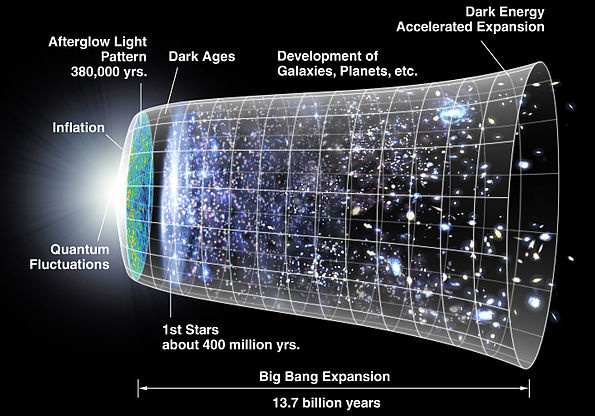Cosmogony
July 3, 2017
Everyone knows the famous
question of the
tree falling in the
forest,
"If a tree falls in a forest and no one is around to hear it, does it make a sound?"
While
philosophers have many reasons to argue the point,
physicists are fairly certain that
sound is produced in all
classical mechanical situations such as this,
independent of an observer. However, if the "tree" exists in the
quantum realm, it will not have fallen
until observed.
The
Roman philosopher,
Lucretius (99 BC - c. 55 BC), actually explored this idea in 50
BC in relation to the
origin of the universe in his
book,
De Rerum Natura (On the Nature of Things). Lucretius traced the origin of the
universe to the point at which
human history was first recorded, and he wrote that the universe would have its end when
men ceased to exist. If
paleontology had existed as a
science in Lucretius' time, he might have had a different opinion.

Lucretius (99 BC - c. 55 BC) was among the atomists, although his writing were much later than the early atomists, such as Democritus (c. 460 - c. 370 BC). (Lucretius image, a 1682 engraving by Michael Burghers, via Wikimedia Commons. Latin text and English translation by William Ellery Leonard from Tufts University Project Perseus.[1] Click for larger image.)
At the other extreme, we have the idea of a universe with neither beginning nor ending. This is the
steady-state theory of the universe that I discussed in a
previous article (Clinging to Theory, August 18, 2016). While the steady state universe had a basis in
scientific theory, rather than
philosophy, the progress in
cosmology made the theory far less tenable than the current
Big Bang cosmology.
Since
universal expansion is now viewed as a certainty, it's a requirement of a steady-state universe that
matter is
continually created as the universe expands. Such matter need only be created at a rate of just one
hydrogen atom per
cubic meter per
billion years, a process that's quite undetectable. The number of
cosmologists who still believe in the steady-state universe might just fit in a single, very small,
conference room.[3]
Helge Kragh of the
Niels Bohr Institute, the
University of Copenhagen (Copenhagen, Denmark), has just
published a
paper on
arXiv that reviews these, and other theories of
cosmogony.[4] This paper is an
English version of a book chapter that is expected to be published later in the year. This book, entitled, Orígenes, is edited by
Ángel Díaz de Rada of the
Open University, Spain, and it will appear in
Spanish. I wrote about Kragh's work in three previous articles (
Bohr Model of the Atom, January 3, 2012;
Vegard and the Periodic Table, January 24, 2012; and,
Radioactivity, November 5, 2014.
These contrary conceptions of the universe as being either eternal or having an origin have existed throughout history. In the cosmogony of the
ancient Egyptian and
Mesopotamian civilizations, everything was created from an undifferentiated
chaos that was separated into the
heavens and the
Earth. This is true, also, in
Hesiod's Theogony. Whether this chaos could be considered to be the universe before such differentiation is not considered.
Aristotle (384 BC-322 BC) was a proponent of a steady state universe of limited
spatial extent, but
temporally infinite in both the
past and
future; that is, it had no creation, and it was indestructible. In
De Caelo (On the Heavens), Aristotle argued that the universe's appearing from some other state at a particular time was
illogical,
"Why, after an infinity of not being, was it generated, at one moment rather than another? If there is no reason and the moments are infinite in number, it is clear that a generated or destructible thing existed for an infinite time."[4]
Many of the early
astronomers still believed in a
literal interpretation of the Bible, so they addressed the creation problem through biblical
chronology rather than through science.
Johannes Kepler (1571-1630) calculated that God had created the universe in 3,983 BC. As I wrote in a
previous article (Newton's Chronology, March 6, 2013),
Isaac Newton's chronology, "
The Chronology of Ancient Kingdoms," was published,
posthumously, in 1728.
Newton's objective was not to discover a start to the universe, but a start to history. In his chronology, Newton makes use of an
astronomical phenomenon, the
precession of the equinoxes, to date world events. The earliest recorded date he could verify was a reference to an
Egyptian Pharaoh, possibly
Ramesses IX, in 1125 BC. This is about a hundred years after the
Trojan War.

A 1689 portrait of Isaac Newton (1642-1727) by Godfrey Kneller (1646-1723).
(Via Wikimedia Commons.)
The prolific
German philosopher,
Immanuel Kant (1724-1804), published his
Allgemeine Naturgeschichte und Theorie des Himmels (Universal History and Theory of the Heavens) in 1755. In Kant's theory of the universe, it all began with a chaos of
particles that then ordered themselves according to
classical mechanics to
condense into the universe. The
laws of physics are as important as
matter itself in Kant's universe, and the universe is creating new versions of itself as time progresses.
After the time of Kant and the emergence of the
scientific revolution, cosmogony slowly came under the
purview of science. In 1858, the German astronomer,
Johann von Mädler (1794-1874), was the first to apply the finite
speed of light to observations of the universe. In addressing
Olbers' paradox, he reasoned that the darkness of the
celestial sphere arose from the idea that the
stars had not always existed, and the universe is finite in extent.[4] Von Mädler's idea received attention after the discovery of universal expansion in the 1930s.
More convincing an argument for a finite universe came from the
second law of thermodynamics. According to this law, the universe should evolve into an
equilibrium state of uniform
temperature; and, eventually, it will succumb to a "
heat death." As a consequence of
thermodynamics, the universe must have existed for a finite time, since we would presently be in its heat death stage if it had existed for an infinite period.
The discovery of universal expansion sparked a renewed interest in cosmogony among scientists. The notion that the universe started in a Big Bang was proposed in a letter to
Nature on May 9, 1931, by
Belgian astrophysicist,
Georges Lemaître (1894-1966), who proposed that the entire
mass of the universe was initially contained in an "atom" of chaotic material.[5] Subsequently, in 1948,
Russian-
American physicist,
George Gamow (1904-1968), and his
colleagues,
Ralph Alpher (1921-2007) and
Robert Herman (1914-1997), reasoned that this initial state of the universe was
high energy radiation and not matter. They further proposed the idea of an
oscillating universe, contracting in a "
Big Crunch," then expanding, to contract, again and again.
The triumph of modern cosmology is that we're quite certain that our universe began with a Big Bang
13.799±0.021 billion years ago with a
long future for us to contemplate.

The 13.799±0.021 billion year history of the universe, as determined by the Wilkinson Microwave Anisotropy Probe. (NASA/WMAP Science Team image, via Wikimedia Commons.)
References:
- T. Lucretius Carus, "Of the Nature of Things," Thomas Creech, Trans., J. Matthews (London: 1714), via archive.org.
- Titus Lucretius Carus, "De Rerum Natura," William Ellery Leonard, Trans., E.P. Dutton and Co., J.M. Dent and Sons (New York: 1916), 301 pp., via Tufts University Project Perseus.
- Mario Livio, "Brilliant Blunders: How the Big Bang Beat Out the Steady State Universe," NOVA blog from PBS, June 27, 2013.
- Helge Kragh, "Cosmology and the Origin of the Universe: Historical and Conceptual Perspectives," arXiv, June 2, 2017.
- Yaël Nazé, "Astronomical arguments in Newton's Chronology," arXiv, December 20, 2012.
- Isaac Newton, "The Chronology of Ancient Kingdoms" (Project Gutenberg).
- G. Lemaître, "The Beginning of the World from the Point of View of Quantum Theory," Nature, vol. 127, no. 3210 (May 9, 1931), p. 706, doi:10.1038/127706b0.
Permanent Link to this article
Linked Keywords: Question; tree; forest; "If a tree falls in a forest and no one is around to hear it, does it make a sound?"; philosopher; physicist; sound; classical mechanics; observer effect; quantum mechanics; quantum realm; wave function collapse; Roman Republic; Lucretius (99 BC - c. 55 BC); Anno Domini; BC; cosmogony; origin of the universe; book; De Rerum Natura; universe; history of the world; human history; human; men; paleontology; science; atomism; atomist; Democritus (c. 460 - c. 370 BC); engraving; Michael Burghers; Wikimedia Commons; Latin; English language; translation; William Ellery Leonard; Tufts University Project Perseus; Steady State theory; steady-state theory of the universe; scientific theory; physical cosmology; Big Bang; metric expansion of space; universal expansion; matter; Perfect Cosmological Principle; hydrogen atom; cubic meter; billion years; cosmology; cosmologist; conference room; Helge Kragh; Niels Bohr Institute; University of Copenhagen (Copenhagen, Denmark); scientific literature; publish; academic publishing; paper; arXiv; Ángel Díaz de Rada; Open University, Spain; Spanish language; Ancient Egypt; Mesopotamia; civilization; Chaos (cosmogony); celestial sphere; heaven; Earth; Hesiod; Theogony; Aristotle (384 BC-322 BC); three-dimensional space; spatial; time; temporal; infinity; infinite; past; future; On the Heavens; De Caelo; logic; illogical; astronomer; Biblical literalism; literal interpretation of the Bible; chronology; Johannes Kepler (1571-1630); calculation; calculate; Isaac Newton; The Chronology of Ancient Kingdoms; posthumous; posthumously; astronomy; astronomical; phenomenon; axial precession; precession of the equinoxes; Egypt; Egyptian; Pharaoh; Ramesses IX; Trojan War; portrait; Godfrey Kneller (1646-1723); Germany; German; Immanuel Kant (1724-1804); Allgemeine Naturgeschichte und Theorie des Himmels (Universal History and Theory of the Heavens); elementary particle; classical mechanics; condensation; condense; physical law; laws of physics; matter; scientific revolution; purview; Johann von Mädler (1794-1874); speed of light; Olbers' paradox; celestial sphere; star; second law of thermodynamics; radiative equilibrium; equilibrium state; temperature; heat death of the universe; thermodynamics; Nature; Belgium; Belgian; astrophysicist; Georges Lemaître (1894-1966); mass; Russia; Russian; American; George Gamow (1904-1968); colleague; Ralph Alpher (1921-2007); Robert Herman (1914-1997); high energy; electromagnetic radiation; oscillation; oscillating; Big Crunch; age of the universe; 13.799±0.021 billion year; future of the Earth; Wilkinson Microwave Anisotropy Probe; NASA/WMAP Science Team.